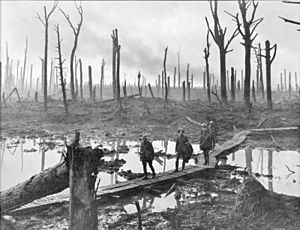Battle of Passchendaele facts for kids
Quick facts for kids Battle of PasschendaeleThird Battle of Ypres |
|||||
|---|---|---|---|---|---|
| Part of the Western Front of the First World War | |||||
 Australian soldiers on a duckboard track in Château Wood near Hooge, 29 October 1917. Photo by Frank Hurley. |
|||||
|
|||||
| Belligerents | |||||
|
|
|||||
| Commanders and leaders | |||||
|
|
|||||
| Casualties and losses | |||||
| 200,000 – 448,614 | 260,400 – 400,000 | ||||
The Battle of Passchendaele was a very big battle during the First World War. It happened from July to November 1917. Soldiers from the Allied side attacked the German Army. The main leaders for the Allies were from Britain.
The battle was fought to control a small village called Passchendaele. This village is close to the town of Ypres in West Flanders, Belgium. The main goal was to "wear out" the German army. It also aimed to protect the Belgian coast. The British commander, Douglas Haig, planned the battle in three parts. These included taking Passchendaele Ridge and moving towards Roeselare.
Contents
The Battle's Challenges
The British launched many huge attacks. They used artillery (big guns), airplanes, and sometimes tanks. But they faced strong German defenses. The German army had modern ways to fight back.
The battle used a tactic called 'bite and hold'. This meant capturing a small piece of land. Then, they would hold onto it against German counter-attacks. This strategy was meant to slowly weaken the German army. The fighting continued until Canadian soldiers captured Passchendaele village on November 6, 1917. The battle mostly ended on November 10.
The Allies gained about 5 miles (8 km) of land. This land was very well defended by the Germans. But the cost was very high. The Allies lost about 140,000 men. This means for every dead soldier, only about 2 inches (5 cm) of ground was gained. The Germans later took back some of this land in 1918.
Fighting in the Mud
Passchendaele is often remembered for its terrible mud. This type of fighting, called attrition warfare, meant slowly wearing down the enemy. It often happened in very muddy conditions. The area around Ypres had many streams and ditches. These were meant to drain the land.
The land was mostly flat and swampy. August 1917 was unusually cold and wet. Heavy artillery attacks also destroyed the ground. This made the drainage systems useless. The battlefield turned into a deep, thick mud.
Even when it was dry in September, mud was still a big problem. Tanks got stuck in the mud. Some soldiers and horses even drowned in it. The highest points in the area were ridges. These ridges were only about sixty meters high. But they had been fought over many times since 1914.
Different Views on the Battle
Many historians have different ideas about this battle. Most of this discussion happens in Britain. Some people say the battle was a waste of soldiers. They point to the huge number of deaths and injuries. They also note that only a small amount of land was gained.
However, other historians have a different view. They say the British Army actually did well. They argue that the British caused many casualties for the German Army. They also believe the battle helped the French army. These historians say the battle helped create new attack tactics. These tactics were important for winning the war in 1918.
The exact number of dead and injured soldiers is still debated. But everyone agrees that hundreds of thousands of soldiers on both sides were killed or hurt. The last soldier from the battle to survive, Harry Patch, died on July 25, 2009. He was also the last survivor of the Western Front in the United Kingdom.
Related pages
Images for kids
See also
 In Spanish: Tercera batalla de Ypres para niños
In Spanish: Tercera batalla de Ypres para niños


















